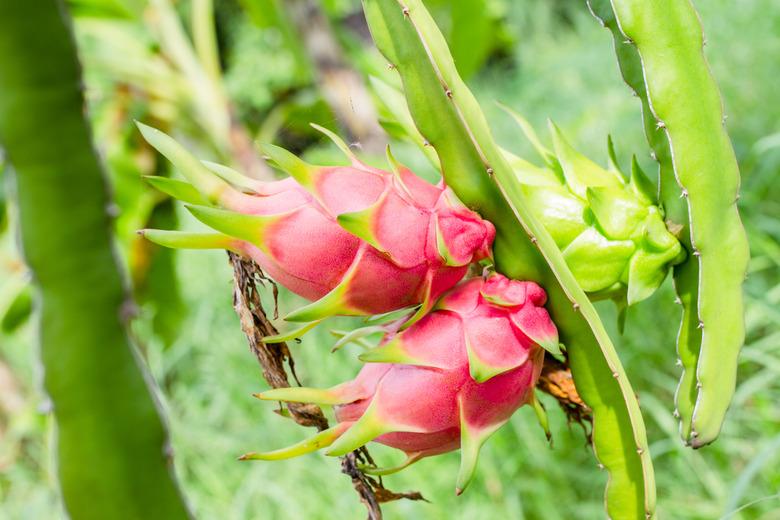How To Water A Dragon Fruit Plant
If you want to add some exotic flair to your garden, look no further than the dragon fruit plant (Hylocereus undatus). Also known as the pitaya cactus, this tropical succulent produces pink or white flowers followed by spiky fruits with white, red or bright purple flesh. Though not difficult to care for, dragon fruit plants are unique and require a bit of special attention. You'll need to pay close attention to your watering schedule, for instance, as too much water is deadly.
Dragon Fruit Basics
Gardeners in U.S. Department of Agriculture plant hardiness zones 9 through 11 can grow dragon fruit outdoors year-round. Others should opt for container planting and bring their dragon fruit tree indoors for the winter before the season's first frost. When doing so, choose a container that's at least 10 inches deep and 15 to 24 inches in diameter.
Wherever you plant your dragon fruit tree, provide well-draining soil. Sandy and loamy soils work best. Heavy soils hold too much water and could kill your plant. Dragon fruits like a soil pH between 6 and 7, so amend your soil if necessary when planting outdoors.
Dragon Fruit Light Requirements
The dragon fruit tree is in the cactus family (Cactaceae) and like other familial plants needs at least six to eight hours of sunlight a day. Once you've chosen a sunny spot, take note of how hot the area gets. Dragon fruit plants thrive in temperatures between 65 and 77 degrees Fahrenheit. Some variation is acceptable, but temperatures above 100 degrees Fahrenheit damage the fruit.
Dragon Fruit Watering Needs
Dragon fruit trees are tropical plants. Because they live in areas of frequent rain showers, the dragon fruit needs more water than its desert cactus cousins. But too much water is as bad as too little.
To strike a balance, make sure your dragon fruit plant gets about an inch of water per week. Dragon fruit planted outdoors may get adequate water from the rain. To avoid overwatering, use a rain gauge to measure how much water Mother Nature gives your plant and then provide more only as needed.
Feeding the Dragon Fruit
Dragon fruit trees are very light feeders, but a little boost now and then doesn't hurt. If desired, fertilize your plant once every two months with a small amount of granular 8-4-12 palm fertilizer. Too much fertilizer will damage a dragon fruit plant, so provide it only during the growing season. To eliminate the guesswork, fertilize only at the recommendations of a soil test. Skip the fertilizer in the winter months or if you have concerns about giving too much.
How to Trellis Train Your Dragon Fruit
As they grow, dragon fruit trees produce airborne roots that branch out, looking for things on which to climb. As a result, you'll need to keep your plant at least 15 feet away from any structure to which you don't want it attaching, like buildings and electrical wires. The plant will need support, however, so provide a sturdy trellis for the dragon fruit tree to climb. Choose or build a trellis capable of supporting at least 200 pounds that consists of a single central post topped with horizontal beams.
To train your plant onto a trellis, cut away any lateral stems that your young dragon fruit tree produces, encouraging only vertical growth until the plant reaches the trellis. Secure the young plant to the vertical trellis post and continue fostering vertical growth. When the plant reaches the desired height, trim the tips of the stems to encourage lateral growth. As it occurs, secure lateral branches to the horizontal trellis beams, creating a tree-like shape.
Harvesting Dragon Fruit
Dragon fruit plants flower from May through August. The fruits follow the flowers and are harvested from July through November. Some varieties can pollinate themselves, but others cannot. For best fruiting, you should plant two different cultivars somewhat close to each other.
The flowers of the dragon fruit have a heavenly vanilla scent but last for one day only. They also bloom at night, relying more on moths and bats to pollinate them than bees. If you're growing your dragon fruit indoors, you'll need to take it outside during flowering season or pollinate the plants by hand to get fruit.
Once formed, a dragon fruit takes about 30 days to ripen. Often said to taste like a mild kiwi, dragon fruit will turn a vibrant color when it's ready to pick. When it's time, cut the fruit away from the plant with clean, sharp pruning shears and enjoy. You can expect your plant to fruit every 12 to 18 months for about 20 years, producing 20 to 60 pounds of fruit each harvest.
